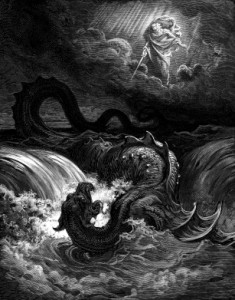Halloween, the ULC, and Monsters

The great sea monster, the Leviathan, is a great beast of the Bible and perhaps inspiration for other beasts like Godzilla
Darker beings and monsters of all colors and sizes can be found all across the texts of the Earth’s major religions. For those who wish to become a pastor for the ULC, studying the inner workings of the world’s most prevalent religions can seem to be a fruitless task. However, some of the monsters of the great religions have a momentous metaphorical meaning and, when interpreted correctly, can even become exciting. For example, creatures such as the Leviathan, the Behemoth and the Ziz have been symbols of the most serious lessons of the Bible and certain Jewish writings, and they were originally created to make a specific metaphorical point about faith and morality.
The tale of the three most prevalent beasts of Judeo-Christianity is a complex and long one. Leviathan, a monstrously giant fish of the sea, is mentioned repeatedly in the Hebrew Bible and in various Jewish sources, including the Jewish midrash. The second creature is Behemoth, a land monster resembling a large ox; it is a creature mentioned alongside Leviathan in the book of Job. In the Jewish midrash, there is both a male and a female Leviathan; to prevent the monsters from reproducing, the female is slain and reserved for a banquet that will be given to the most righteous individuals when the time of the advent of the Messiah has come. The popular Jewish festival, Sukkot, mentions Leviathan in one of its routine prayers. Both of the beasts hold a great deal of metaphorical importance in certain religious communities, and they have been interpreted to mean many things. The air-monster, Ziz, is slightly less well-known but still important for the more serious lessons of religion. The creature is said to resemble a giant griffin, with a wingspan large enough to block out the sun itself. All three of these monsters are mentioned in various religious texts, both in Judaism and Christianity.
For interfaith pastors who have been ordained in the ULC, these monsters can bear a number of different meanings. For several of the most educated people, the monsters themselves are a metaphor for monumental tasks and struggles that may seem impossible at first glance. These beasts and their destiny to be served as food to the righteous can be taken as symbols for humanity being given only what it can handle, and that the spoils may go to those individuals who make the most fervent attempts. Regardless of a person’s individual faith, the tale of the three beasts is a fascinating idea, even to nonbelievers. To become a pastor in the ULC, it is essential to be tolerant of all religions, regardless of their respective beliefs.














